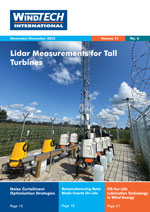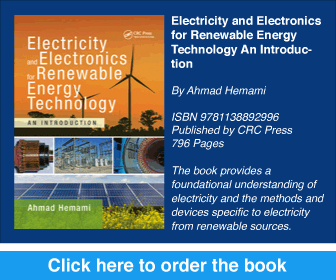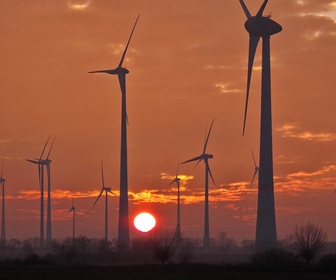- Category: Articles
New Welding and Inspection Methods
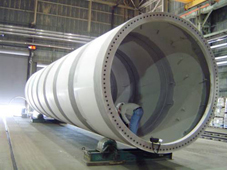 Conical cylinder wind turbine towers are classic examples of welding-dependent structures, where specialised shapes are desired at a large scale. Opportunities exist to increase production efficiency in welding by changing the submerged arc welding (SAW) procedures or by switching to another process, with tandem GMAW and laser hybrid as recommended alternatives. Tandem GMAW and laser hybrid would have advantages particularly when reorientation of parts is an important aspect of the fabrication effort. Phased-array ultrasonic inspection, which is already available for use in similar industries, can greatly increase the amount and quality of inspection information for gauging the importance of subsurface imperfections.
Conical cylinder wind turbine towers are classic examples of welding-dependent structures, where specialised shapes are desired at a large scale. Opportunities exist to increase production efficiency in welding by changing the submerged arc welding (SAW) procedures or by switching to another process, with tandem GMAW and laser hybrid as recommended alternatives. Tandem GMAW and laser hybrid would have advantages particularly when reorientation of parts is an important aspect of the fabrication effort. Phased-array ultrasonic inspection, which is already available for use in similar industries, can greatly increase the amount and quality of inspection information for gauging the importance of subsurface imperfections.
By William Mohr, Principal Engineer, EWI, USA .
 Conical cylinder wind turbine towers are classic examples of welding-dependent structures, where specialised shapes are desired at a large scale. Opportunities exist to increase production efficiency in welding by changing the submerged arc welding (SAW) procedures or by switching to another process, with tandem GMAW and laser hybrid as recommended alternatives. Tandem GMAW and laser hybrid would have advantages particularly when reorientation of parts is an important aspect of the fabrication effort. Phased-array ultrasonic inspection, which is already available for use in similar industries, can greatly increase the amount and quality of inspection information for gauging the importance of subsurface imperfections.
Conical cylinder wind turbine towers are classic examples of welding-dependent structures, where specialised shapes are desired at a large scale. Opportunities exist to increase production efficiency in welding by changing the submerged arc welding (SAW) procedures or by switching to another process, with tandem GMAW and laser hybrid as recommended alternatives. Tandem GMAW and laser hybrid would have advantages particularly when reorientation of parts is an important aspect of the fabrication effort. Phased-array ultrasonic inspection, which is already available for use in similar industries, can greatly increase the amount and quality of inspection information for gauging the importance of subsurface imperfections.By William Mohr, Principal Engineer, EWI, USA .
- Category: Articles
Keeping the World’s Wind Developers Up to Date with the Newest Interconnection Standards
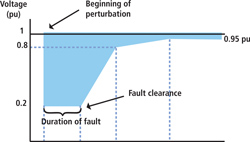 The remarkable growth of wind power generating capacity around the world has created a renewed focus on the fundamental role of interconnection standards for grid reliability. Since the power derived from wind farms is not inherently predictable or controllable – at least to the degree seen in ‘fossil fuel’ generation – precautions must be taken to protect the utility grid. This article describes the application of modern in-turbine dynamic reactive power solutions. Wind generators around the world have deployed these solutions, such as the D-VAR RT, to enable wind turbines to meet the grid reliability standards that now exist in many countries.
The remarkable growth of wind power generating capacity around the world has created a renewed focus on the fundamental role of interconnection standards for grid reliability. Since the power derived from wind farms is not inherently predictable or controllable – at least to the degree seen in ‘fossil fuel’ generation – precautions must be taken to protect the utility grid. This article describes the application of modern in-turbine dynamic reactive power solutions. Wind generators around the world have deployed these solutions, such as the D-VAR RT, to enable wind turbines to meet the grid reliability standards that now exist in many countries.
By Tony Siebert, Director of FACTS and D-VAR Business, AMSC Power Systems, Germany .
 The remarkable growth of wind power generating capacity around the world has created a renewed focus on the fundamental role of interconnection standards for grid reliability. Since the power derived from wind farms is not inherently predictable or controllable – at least to the degree seen in ‘fossil fuel’ generation – precautions must be taken to protect the utility grid. This article describes the application of modern in-turbine dynamic reactive power solutions. Wind generators around the world have deployed these solutions, such as the D-VAR RT, to enable wind turbines to meet the grid reliability standards that now exist in many countries.
The remarkable growth of wind power generating capacity around the world has created a renewed focus on the fundamental role of interconnection standards for grid reliability. Since the power derived from wind farms is not inherently predictable or controllable – at least to the degree seen in ‘fossil fuel’ generation – precautions must be taken to protect the utility grid. This article describes the application of modern in-turbine dynamic reactive power solutions. Wind generators around the world have deployed these solutions, such as the D-VAR RT, to enable wind turbines to meet the grid reliability standards that now exist in many countries.By Tony Siebert, Director of FACTS and D-VAR Business, AMSC Power Systems, Germany .
- Category: Articles
Alignment with Target Values Reduces Vibrations
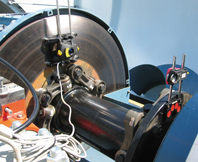 Misalignment in the drive trains of wind turbines can cause vibrations that reduce the service life and availability of gears and generators. These errors can be identified by means of vibration measurements or by using condition monitoring systems.
Misalignment in the drive trains of wind turbines can cause vibrations that reduce the service life and availability of gears and generators. These errors can be identified by means of vibration measurements or by using condition monitoring systems.
By Dr Edwin Becker and Ole Holstein, PRÜFTECHNIK, Germany .
 Misalignment in the drive trains of wind turbines can cause vibrations that reduce the service life and availability of gears and generators. These errors can be identified by means of vibration measurements or by using condition monitoring systems.
Misalignment in the drive trains of wind turbines can cause vibrations that reduce the service life and availability of gears and generators. These errors can be identified by means of vibration measurements or by using condition monitoring systems.By Dr Edwin Becker and Ole Holstein, PRÜFTECHNIK, Germany .
- Category: Articles
Dynamic Load Simulation of Multi-Megawatt Wind Turbine Gearboxes
 Today’s wind turbine market, characterised by continuous up-scaling into the multi-megawatt class, is calling for reliability as the number one requirement. Cascading down this requirement to each component manufacturer in the supply chain, the gearbox manufacturer’s challenge is to deliver a drive system, at a high quality level, that will operate in a highly dynamic environment. Reliable drive train design requires good understanding of the gear unit and its dynamic behaviour, particularly in the operational conditions experienced in a wind turbine. Component design, based on mechanical design loads in combination with (partial) safety factors, as described in current industry standards is not (yet) covering all requirements. There is further room for improvement based on validated and advanced simulation methods that can support the gearbox designer in developing a reliable drive system tailored to the wind turbine manufacturer’s current and future needs.
Today’s wind turbine market, characterised by continuous up-scaling into the multi-megawatt class, is calling for reliability as the number one requirement. Cascading down this requirement to each component manufacturer in the supply chain, the gearbox manufacturer’s challenge is to deliver a drive system, at a high quality level, that will operate in a highly dynamic environment. Reliable drive train design requires good understanding of the gear unit and its dynamic behaviour, particularly in the operational conditions experienced in a wind turbine. Component design, based on mechanical design loads in combination with (partial) safety factors, as described in current industry standards is not (yet) covering all requirements. There is further room for improvement based on validated and advanced simulation methods that can support the gearbox designer in developing a reliable drive system tailored to the wind turbine manufacturer’s current and future needs.
By Sonja Goris, Hansen Transmissions, Belgium .
 Today’s wind turbine market, characterised by continuous up-scaling into the multi-megawatt class, is calling for reliability as the number one requirement. Cascading down this requirement to each component manufacturer in the supply chain, the gearbox manufacturer’s challenge is to deliver a drive system, at a high quality level, that will operate in a highly dynamic environment. Reliable drive train design requires good understanding of the gear unit and its dynamic behaviour, particularly in the operational conditions experienced in a wind turbine. Component design, based on mechanical design loads in combination with (partial) safety factors, as described in current industry standards is not (yet) covering all requirements. There is further room for improvement based on validated and advanced simulation methods that can support the gearbox designer in developing a reliable drive system tailored to the wind turbine manufacturer’s current and future needs.
Today’s wind turbine market, characterised by continuous up-scaling into the multi-megawatt class, is calling for reliability as the number one requirement. Cascading down this requirement to each component manufacturer in the supply chain, the gearbox manufacturer’s challenge is to deliver a drive system, at a high quality level, that will operate in a highly dynamic environment. Reliable drive train design requires good understanding of the gear unit and its dynamic behaviour, particularly in the operational conditions experienced in a wind turbine. Component design, based on mechanical design loads in combination with (partial) safety factors, as described in current industry standards is not (yet) covering all requirements. There is further room for improvement based on validated and advanced simulation methods that can support the gearbox designer in developing a reliable drive system tailored to the wind turbine manufacturer’s current and future needs.By Sonja Goris, Hansen Transmissions, Belgium .
- Category: Articles
Invention Changes the World Wind Map
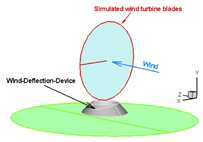 At a time when an improvement in efficiency from a large wind turbine of 1–2% is highly significant, a new company called Leviathan Energy has demonstrated that it can improve the power output of large wind turbines by over 40%, and at times of slow wind by over 100%.
At a time when an improvement in efficiency from a large wind turbine of 1–2% is highly significant, a new company called Leviathan Energy has demonstrated that it can improve the power output of large wind turbines by over 40%, and at times of slow wind by over 100%.
By Dr Daniel Farb, CEO, Leviathan Energy, Inc, USA .
 At a time when an improvement in efficiency from a large wind turbine of 1–2% is highly significant, a new company called Leviathan Energy has demonstrated that it can improve the power output of large wind turbines by over 40%, and at times of slow wind by over 100%.
At a time when an improvement in efficiency from a large wind turbine of 1–2% is highly significant, a new company called Leviathan Energy has demonstrated that it can improve the power output of large wind turbines by over 40%, and at times of slow wind by over 100%.By Dr Daniel Farb, CEO, Leviathan Energy, Inc, USA .
- Category: Articles
Co-Existence Between Radars and Turbines Offshore
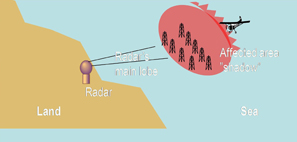 In Sweden the Swedish Armed Forces take every wind power project under consideration, and give their opinion about it. In particular, planned offshore wind power plants present some significant challenges. How can co-existence between radars and wind power plants be ensured? One significant problem is the radar shadow behind the turbines. The turbines can ‘conceal’ a target that otherwise should have been detected by the radar. One can illustrate the situation by shining a light on an obstacle. There will be a shadow behind the obstacle. Flight tests have been carried out to investigate the reality of the shadow effect, and a study has been done to find possible solutions that will enable radars and wind turbines to co-exist safely.
In Sweden the Swedish Armed Forces take every wind power project under consideration, and give their opinion about it. In particular, planned offshore wind power plants present some significant challenges. How can co-existence between radars and wind power plants be ensured? One significant problem is the radar shadow behind the turbines. The turbines can ‘conceal’ a target that otherwise should have been detected by the radar. One can illustrate the situation by shining a light on an obstacle. There will be a shadow behind the obstacle. Flight tests have been carried out to investigate the reality of the shadow effect, and a study has been done to find possible solutions that will enable radars and wind turbines to co-exist safely.
By Kjell-Åke Eriksson, Swedish Defence Materiel Administration (FMV), Sweden .
 In Sweden the Swedish Armed Forces take every wind power project under consideration, and give their opinion about it. In particular, planned offshore wind power plants present some significant challenges. How can co-existence between radars and wind power plants be ensured? One significant problem is the radar shadow behind the turbines. The turbines can ‘conceal’ a target that otherwise should have been detected by the radar. One can illustrate the situation by shining a light on an obstacle. There will be a shadow behind the obstacle. Flight tests have been carried out to investigate the reality of the shadow effect, and a study has been done to find possible solutions that will enable radars and wind turbines to co-exist safely.
In Sweden the Swedish Armed Forces take every wind power project under consideration, and give their opinion about it. In particular, planned offshore wind power plants present some significant challenges. How can co-existence between radars and wind power plants be ensured? One significant problem is the radar shadow behind the turbines. The turbines can ‘conceal’ a target that otherwise should have been detected by the radar. One can illustrate the situation by shining a light on an obstacle. There will be a shadow behind the obstacle. Flight tests have been carried out to investigate the reality of the shadow effect, and a study has been done to find possible solutions that will enable radars and wind turbines to co-exist safely.By Kjell-Åke Eriksson, Swedish Defence Materiel Administration (FMV), Sweden .
- Category: Articles
The Marginal Cost to Automate the Wind Farm Grid-Intertie Substation
We have many sayings in the USA that come from our 17th century European roots. One of the sayings still heard today is: ‘penny-wise and pound-foolish’. We see a clear circumstance in which to use this old proverb in wind farm automation. Nearly all utility-scale wind farm management systems have state-of-the-art automatically controlled wind turbines, but at the electric grid-intertie, the substation is very often managed manually. It is true that some substations may have remote control capabilities, but they are still completely manually controlled, and require operator intervention for restoration. The real irony is that the cost of implementing a full auto-restoration scheme at a modern substation, with intelligent electronic protection devices, is likely to be only the lost revenue of one extended substation outage – truly ‘penny-wise and pound-foolish’ if not implemented.
By Larry D. Elliott PE, and Lawrence C. Gross, Jr PE, Relay Application Innovation Inc., USA .
We have many sayings in the USA that come from our 17th century European roots. One of the sayings still heard today is: ‘penny-wise and pound-foolish’. We see a clear circumstance in which to use this old proverb in wind farm automation. Nearly all utility-scale wind farm management systems have state-of-the-art automatically controlled wind turbines, but at the electric grid-intertie, the substation is very often managed manually. It is true that some substations may have remote control capabilities, but they are still completely manually controlled, and require operator intervention for restoration. The real irony is that the cost of implementing a full auto-restoration scheme at a modern substation, with intelligent electronic protection devices, is likely to be only the lost revenue of one extended substation outage – truly ‘penny-wise and pound-foolish’ if not implemented.
By Larry D. Elliott PE, and Lawrence C. Gross, Jr PE, Relay Application Innovation Inc., USA .
Use of cookies
Windtech International wants to make your visit to our website as pleasant as possible. That is why we place cookies on your computer that remember your preferences. With anonymous information about your site use you also help us to improve the website. Of course we will ask for your permission first. Click Accept to use all functions of the Windtech International website.



